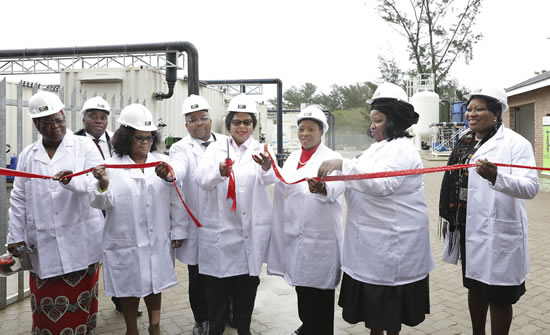Desalination plant relieves KZN drought
Desalination plant relieves KZN drought Estelle GreeffA new R300 million mobile desalination plant in Richards Bay is turning salty seawater into fresh drinking water for more than 150 000 KZN households.
 KwaZulu-Natal has been hit hard by the recent drought. The province lies on the Indian Ocean coast, but all that salty sea water gives no relief. Today, a new mobile desalination plant in Richards Bay is processing sea water into 10-million litres of fresh water every day.
KwaZulu-Natal has been hit hard by the recent drought. The province lies on the Indian Ocean coast, but all that salty sea water gives no relief. Today, a new mobile desalination plant in Richards Bay is processing sea water into 10-million litres of fresh water every day.
This water is pumped to reservoirs in Richards Bay, which have gone from an average of 55 per cent to 90 per cent full. From there, the water is piped to more than 150 000 households in Madlazini, Mereensee, eNseleni, eSikhaleni, Ngwelezana, KwaDlangezwa, Felixton and surrounding areas.
The R300 million plant was recently launched by Minister of Water and Sanitation Nomvula Mokonyane. It is the first, largest and most modern mobile sea water purification unit in South Africa, made up of 10 desalination containers next to the water treatment plant at Richard Bay’s Alkantsrand Beach.
Two-year drought
KwaZulu-Natal had suffered drought for over two years, the Minister said. In December 2014 the provincial government declared a drought in the province. By August 2016, Richards Bay’s main water supply had dropped to a dangerously low level of 16 per cent.
“The desalination plant is now 100 per cent complete and functional,” Minister Mokonyane said. “The plant started to produce water on 14 November 2016, and a total of 10 megalitres a day of production was commissioned by 25 January 2017.”
One of the beneficiaries is Gogo Lina Gumede, who said her household had been without water for two years.
“The yard tap dried up long time ago. We have been drinking water from the MaNdlazini River. We were sharing that water with cows and goats. But now there is a plant we hope the water scarcity problem will be solved and we will drink clean safe water again.”